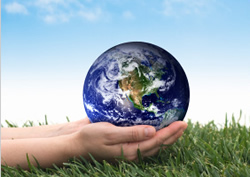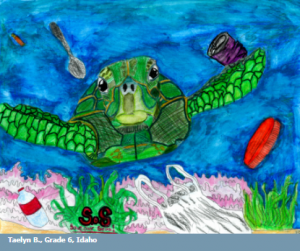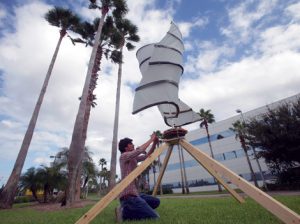Earth Day Resources
 Kids love exploring the world around them, and Earth Day offers a great way to introduce them to environmental science and engineering. The following sampler includes activities, lessons, and resources ranging from starting a school-wide energy audit to “green” buildings, the science behind solar ovens, and sustainable design.
Kids love exploring the world around them, and Earth Day offers a great way to introduce them to environmental science and engineering. The following sampler includes activities, lessons, and resources ranging from starting a school-wide energy audit to “green” buildings, the science behind solar ovens, and sustainable design.
NASA’s STEM Earth Toolkit offers curated K-12 activities, tools, and other resources for classroom teachers. Also check out the space agency’s Earth Day Resources for Informal Educators, including such activities as how to read a heat map, the Jet Propulsion Lab’s Earth Day Resources for Educators. NASA’s Adopt the Planet campaign invited people around the world to celebrate Earth Day 2017 by virtually adopting one of 64,000 pieces of Earth as seen from space. A personalized adoption certificate featuring data from NASA’s Earth-observing satellites for a randomly assigned location can be printed out and shared.
NASA also offers free educator professional development webinars hosted by the NASA STEM Engagement & Educator Professional Development Collaborative at Texas State University, and a searchable online library of STEM education materials that educators can use in their environmental and geoscience classes.
Earth Day Network has information on its campaigns, such as the 2018 End Plastic Pollution campaign and a 2017 Climate Week Toolkit for Teachers [PDF] that includes tips for family activities, civic action, and science classes. Click HERE to see toolkits for teachers, universities, and others.
NOAA’s Marine Debris Program includes “Trash Talk,” an Emmy-award winning video series aimed at students and teachers, and a citizen-science project on monitoring marine debris that includes a Marine Debris Tracker app developed by the University of Georgia’s college of engineering that lets anyone report and map plastic waste and other coastal litter. There’s also an annual student marine-debris art contest! 
EPA’s Earth Day site offers ideas for teachers, classroom activities, and community service projects along with a history of Earth Day. EPA also has a carbon footprint calculator for measuring household carbon emissions, and The Quest for Less [PDF], a dated but still usefull teacher’s guide and activities – one featuring Dr. Seuss – on reducing, reusing, and recycling.
The Plastic Pollution Coalition‘s educational resources include curriculum.
Engineering, Go For It Activities and Lessons:
AIR POLLUTION
- I Breathe What?! (grades 6-8)
- Cleaning the Air (grades 6-7) (TeachEngineering companion activity)
AGRICULTURE & WASTE DISPOSAL
- Engineer a Vertical Farm (grades 6-8)
- Landfills and contamination (grades 9-12)
- Map the Green Space (grades 5-9)
- Biosolarization: Sustainable Weed Killer (grades 5-7)
- Design a Rooftop Garden (grades 6-9)
- The Energy of Decay (grades K-5)
- Trash Talkin’ (grades 3-5)
- What a Dump! (grades 3-5)
- Life After Trash (grades 6-8)
- Trash Sliders (grades 6-8)
SOLAR ENERGY
- Build a Solar Still (grades 3-8)
- Daylighting Design (grades 9-12)
- Berry Organic Solar Energy (grades 9-12)
- Green Roof Design (grades 9-12)
- Living Together to Work Together
WATER POLLUTION
- Pollution in Our Watershed (grades 2-8)
- Oil Spill Solutions (grades 3-12)
- Harvest Water from Fog (grades 4-12)
- Dirty Water Project (grades 3-5)
- Groundwater Pollution Detectives (grades 7-9)
- Ahoy! Plastics in the Ocean (grades 6-9)
WIND and ALTERNATIVE ENERGY
- Harnessing Wind (grades 3-5)
- Wind Power for Your Home (grades 9-11)
- Zero-Energy Home Design (grades 9-11)
See also: eGFI Teachers’ Sustainability Education Resources and eGFI Teachers’ Green Roof Resources
Activities and Projects:
- Engineering is Elementary‘s Water Reuse: Testing the Waters is a free, downloadable engineering design challenge for middle school students created by the Museum of Science, Boston, in partnership with NASA. EiE also created a video report on bioplastics – creating plastics from plants instead of chemicals. [YouTube 10:48]
- TeachEngineering, from the University of Colorado Boulder’s College of Engineering, guides 7th-9th grade students on a field trip to identify and map the plastics in their area.
- Green Education Foundation’s Green Energy Challenges, Green Thumb Challengeand associated curriculum,Waste Reduction curriculum and activities, and Top 10 Earth Day Projects emphasize the “active” in classroom activities. Ideas include desigining a walkable route to school, energy audits, and other “green team” activities!
- SENSE IT is a free, standards-based curriculum for middle and high school students that instills technical skills and sense of environmental stewardship by building, deploying, and analyzing data from wireless water-quality sensors that monitor the health of a local river or stream.
- The U.S. Environmental Protection Agency’s Earth Day site offers lessons for teachers, community service ideas, and a history of Earth Day. EPA also has free online lesson plans and other environmental education resources, including STEM activities focused on Air Quality and Energy Choice and promoting healthy school environments.
- NASA’s Climate Kids has interactive games, videos, and other fun resources about weather and climate change for elementary school-age children.
- HowToSmile.org’s environmental science activities for various age groups.
Citizen-Science Sites:
- The Cool School Challenge, sponsored by the World Wildlife Fund and developed by a high school environmental educator, engages students and teachers in practical strategies to reduce carbon dioxide (CO2) and other greenhouse gas emissions school-wide. Schools that complete the Challenge automatically qualify for a bronze level award through the Eco-Schools USA program!
- Project Noah is a site for citizen-scientists (and curious kids) around the world to explore and document wildlife by uploading photos of beautiful, strange, or unknown creatures and finding out what they are.
- Marine Debris Monitoring and Assessment Project. NOAA’s worldwide project to map and track the flow of plastic and other trash in the world’s oceans includes a Marine Debris Tracker app developed by the University of Georgia’s college of engineering.
Earth Day-themed newsletters, articles, and videos from our eGfi blogs:
eGFI Teachers’ newsletters:
- Resiliance and Renewal (April 2021)
- Cleaning Up Our Act: Earth Day Turns 50 (April 2020)
- Bound for Glory: Transcontinental Railway Turns 150 (April 2019)
- Planet Plastic (April 2018)
- As the Earth Glows (April 2017)
- Moving (Trash) Mountains (April 2016)
- Make a Splash (April 2015)
- Catch Wind of Earth Day! (April 2014)
- Earth Day (April 18, 2013)
- Handle with Care (April 17, 2012)
- Acts of Green’ Span the Globe (April 12, 2011)
- Earth Day at 40 (April 3, 2010)
Features from our eGfi Students and Teachers blogs: 
- Engineering the New Normal (building resilience in developing communities)
- Pioneer of Green Learning (high school sustainability teacher Mike Town)
- Houses Could be Powered by Artificial Leaves (green design)
- Energy-generating Waterfall Proposed for 2016 Olympics (waterfall in Rio)
- Sustainability Workshop from Autodesk (video series)
- World’s Greenest Office Building? (sustainable design)
- Green Roofs (sustainable design)
- Sustainable Slopes (indoor snow park in Sweden)
- Power Walk Floor Tiles (pedestrian-generated electricity)
- Student Inventor Manu Sharma (engineering student designs wind turbines)
- Novel Wind Turbines (nature-inspired shapes)
- Student Inventors Flush with Savings (Cooper Union students invent cheap dual-flush converter to save water)
- Earth Day, Every Day (Environmental engineer Alexandra Boehm) (2010)
- Bill Gates Wants to Reinvent the Toilet (Gates Foundation’s toilet challenge)
- Turning Air Into Water (Australian grad student devises method to wring water from desert air)
- Students Converge to Solve Water Woes (Pittsburgh high school students attend video conference with global peers)
- Students Create Water Disinfecting Tool (University of Washington engineering students win prize for water-purification system)
- Hidden Wealth in Food Waste? (urban composting)
- Low-Cost Housing from Loofah and Plastic Waste (video of Elsa Zaldivar’s project)
- Room to Grow (vertical farming) (ASEE Prism magazine 2018) and the eGFI Teachers’ blog post version
- Meet Boyan Slat & the Ocean Plastics Cleanup Crew (booms, water wheels, and other efforts to tackle plastic marine debris) (2018)
- Plastic Hits the Road (2018 article on building roads using plastic waste)
- Hidden Wealth in Food Waste (energy from garbage) (ASEE Prism magazine 2015)
- Tough Fiber (ASEE Prism magazine 2018 cover story on bamboo as a sustainable building material)
updated 4/21/17
Filed under: Class Activities, Grades 6-8, Grades 9-12, Grades K-5, K-12 Outreach Programs, Lesson Plans, Special Features, Web Resources
Tags: Class Activities, Curriculum, Earth Day, Energy, Engineering is Everywhere, Environmental Engineering, Environmental science, Green design, green roof, groundwater, Internet Resources, inventor, Lesson Plan, Lesson Plans, marine debris, NOAA, Ocean Cleanup, plastic, Pollution, Resources for Teachers, SENSE IT, Sustainability, Teacher Resources, Trash, vertical farming, Videos, waste, Web Resources, Wind Energy








